Apollo 20 hardware reassigned to Skylab
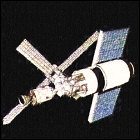 NASA formally cancels the planned Apollo 20 mission to the moon’s Copernicus crater in order to begin converting the upper stage of the mission’s Saturn V rocket into the Skylab space station, to be launched in the early 1970s. Construction of the Apollo command/service module and lunar module scheduled to fly this mission was halted before either vehicle was completed. The crew would have consisted of Stu Roosa, Paul Weitz and Jack Lousma; ironically, Weitz was transferred to the first Skylab crew, while Lousma was part of the second Skylab crew. Both later flew on shuttle missions.
NASA formally cancels the planned Apollo 20 mission to the moon’s Copernicus crater in order to begin converting the upper stage of the mission’s Saturn V rocket into the Skylab space station, to be launched in the early 1970s. Construction of the Apollo command/service module and lunar module scheduled to fly this mission was halted before either vehicle was completed. The crew would have consisted of Stu Roosa, Paul Weitz and Jack Lousma; ironically, Weitz was transferred to the first Skylab crew, while Lousma was part of the second Skylab crew. Both later flew on shuttle missions.

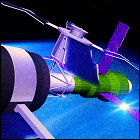 With planning already well underway for the Apollo-Soyuz mission which won’t take place until
With planning already well underway for the Apollo-Soyuz mission which won’t take place until 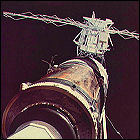 The first American space station,
The first American space station, 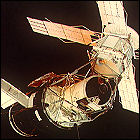 The first three-man Skylab crew lifts off to undertake a mission far different from the one for which they had trained. Their primary objective is now to save the crippled station from the damage it suffered during launch; as it is, Skylab is uninhabitable, with temperatures in its workshop and crew quarters soaring above 100 degrees, threatening to heat up items inside enough to fill the space with toxic gases. The first repair spacewalk takes place less than 24 hours after the crew arrives in an Apollo capsule, and succeeds in starting to drop the temperature inside.
The first three-man Skylab crew lifts off to undertake a mission far different from the one for which they had trained. Their primary objective is now to save the crippled station from the damage it suffered during launch; as it is, Skylab is uninhabitable, with temperatures in its workshop and crew quarters soaring above 100 degrees, threatening to heat up items inside enough to fill the space with toxic gases. The first repair spacewalk takes place less than 24 hours after the crew arrives in an Apollo capsule, and succeeds in starting to drop the temperature inside.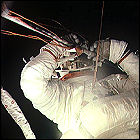 Two members of
Two members of 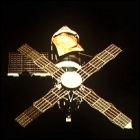 Having repaired and secured the damaged Skylab over the course of three spacewalks, the space station’s first three-man crew leaves the station and returns to Earth after 28 days in space, experiencing gravity after nearly a month of zero-G.
Having repaired and secured the damaged Skylab over the course of three spacewalks, the space station’s first three-man crew leaves the station and returns to Earth after 28 days in space, experiencing gravity after nearly a month of zero-G.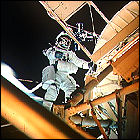 With the first Skylab crew having salvaged the first American space station, the second crew – designated Skylab 3 – lifts off for another long-term stay in space. Alan Bean, Jack Lousma and Owen Garriott spend 59 days aboard Skylab, performing a spacewalk to conduct further repairs to their damaged space station, investigating the effects of long-duration weightlessness and space travel on the human body, and observing the sun through Skylab’s solar telescope system. A thruster leak in the Apollo command/service module forces NASA to consider a rescue mission.
With the first Skylab crew having salvaged the first American space station, the second crew – designated Skylab 3 – lifts off for another long-term stay in space. Alan Bean, Jack Lousma and Owen Garriott spend 59 days aboard Skylab, performing a spacewalk to conduct further repairs to their damaged space station, investigating the effects of long-duration weightlessness and space travel on the human body, and observing the sun through Skylab’s solar telescope system. A thruster leak in the Apollo command/service module forces NASA to consider a rescue mission.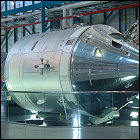 A thruster leak in the Skylab 3 crew’s Apollo command/service module forces NASA to consider a Skylab Rescue mission using a modified five-seater Apollo vehicle, mounted atop a Saturn IB and rolled out to the pad in readiness for the emergency flight. NASA brings in enough engineers and employees to have shifts working around the clock, seven days a week, to get the emergency mission ready for launch on September 9th. The thruster issue is later resolved, and the first-ever planned space rescue mission stands down. Astronauts Vance Brand and Don Lind are assigned to the rescue mission; both men later flew the Space Shuttle, though Brand will also fly in the Apollo-Soyuz Test Project. The modified command/service module and Saturn rocket are retained in case a rescue is needed for the final Skylab flight, and then as an Apollo-Soyuz backup vehicle, before being retired and displayed at the Smithsonian and Kennedy Space Center.
A thruster leak in the Skylab 3 crew’s Apollo command/service module forces NASA to consider a Skylab Rescue mission using a modified five-seater Apollo vehicle, mounted atop a Saturn IB and rolled out to the pad in readiness for the emergency flight. NASA brings in enough engineers and employees to have shifts working around the clock, seven days a week, to get the emergency mission ready for launch on September 9th. The thruster issue is later resolved, and the first-ever planned space rescue mission stands down. Astronauts Vance Brand and Don Lind are assigned to the rescue mission; both men later flew the Space Shuttle, though Brand will also fly in the Apollo-Soyuz Test Project. The modified command/service module and Saturn rocket are retained in case a rescue is needed for the final Skylab flight, and then as an Apollo-Soyuz backup vehicle, before being retired and displayed at the Smithsonian and Kennedy Space Center.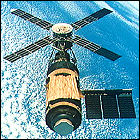 The third and final crew of the first American space station, Skylab 4, lifts off for an 84-day stay. The crew’s tasks include medical and biological experiments, solar observations (including the first space-based recording of solar flare origination), and observations of Comet Kohoutek. Crewmembers Gerald Carr, William Pogue and Edward Gibson have a frank discussion with ground controllers about their extremely busy work schedule (similar to heated discussions between Apollo 7’s crew and Houston) halfway through the nearly-three-month mission. Skylab is left powered down, but still habitable, at the end of the crew’s stay, in anticipation that future Space Shuttle crews will someday occupy Skylab.
The third and final crew of the first American space station, Skylab 4, lifts off for an 84-day stay. The crew’s tasks include medical and biological experiments, solar observations (including the first space-based recording of solar flare origination), and observations of Comet Kohoutek. Crewmembers Gerald Carr, William Pogue and Edward Gibson have a frank discussion with ground controllers about their extremely busy work schedule (similar to heated discussions between Apollo 7’s crew and Houston) halfway through the nearly-three-month mission. Skylab is left powered down, but still habitable, at the end of the crew’s stay, in anticipation that future Space Shuttle crews will someday occupy Skylab.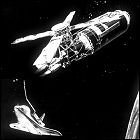 NASA and its contractors mull over a report outlining an ambitious (and, considering the continuous delays to the first launch of the Space Shuttle program, overly optimistic) plan to reactivate and occupy the Apollo-era space station Skylab for use by shuttle crews. The plan involves outfitting the ailing station with new solar power panels and equipment, and performing repairs to make it habitable for future astronauts. Despite the best-laid plans, however, the shuttle’s first launch comes after Skylab tumbles back through Earth’s atmosphere.
NASA and its contractors mull over a report outlining an ambitious (and, considering the continuous delays to the first launch of the Space Shuttle program, overly optimistic) plan to reactivate and occupy the Apollo-era space station Skylab for use by shuttle crews. The plan involves outfitting the ailing station with new solar power panels and equipment, and performing repairs to make it habitable for future astronauts. Despite the best-laid plans, however, the shuttle’s first launch comes after Skylab tumbles back through Earth’s atmosphere.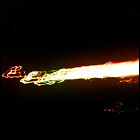 After intense solar activity results in a brief swelling of Earth’s atmosphere,
After intense solar activity results in a brief swelling of Earth’s atmosphere, 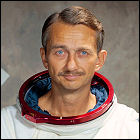 Skylab and Space Shuttle astronaut Owen K. Garriott dies at the age of 88. Born in Oklahoma, former U.S. Navy electronics officer Garriott went on to Stanford University to pursue a doctorate, and returned to Stanford to teach physics and electronics until
Skylab and Space Shuttle astronaut Owen K. Garriott dies at the age of 88. Born in Oklahoma, former U.S. Navy electronics officer Garriott went on to Stanford University to pursue a doctorate, and returned to Stanford to teach physics and electronics until 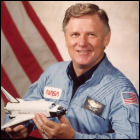 Don Lind, a veteran of the Apollo, Skylab and space shuttle eras at NASA, dies at the age of 92. Born in Midvale, Utah, his service as a U.S. Navy pilot and a degree in nuclear physics brought him to the attention of NASA, and he was a member of the agency’s fifth astronaut class, many of whom went to the moon. Lind was considered for the crew of Apollo 20 until
Don Lind, a veteran of the Apollo, Skylab and space shuttle eras at NASA, dies at the age of 92. Born in Midvale, Utah, his service as a U.S. Navy pilot and a degree in nuclear physics brought him to the attention of NASA, and he was a member of the agency’s fifth astronaut class, many of whom went to the moon. Lind was considered for the crew of Apollo 20 until